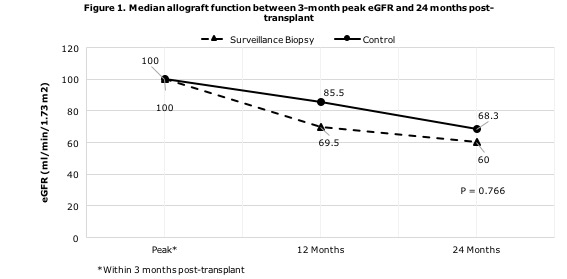Impact of Six-Month Surveillance Biopsies and Monitoring on 2-Year Outcomes in Pediatric Renal Transplant Recipients
1University Health System, The University of Texas at Austin, College of Pharmacy, Pharmacotherapy Division, Austin, TX, The University of Texas Health Science Center at San Antonio, San Antonio, TX, 2University Health System, The University of Texas Health Science Center at San Antonio, San Antonio, TX
Meeting: 2019 American Transplant Congress
Abstract number: C236
Keywords: Graft function, Protocol biopsy, Rejection
Session Information
Session Name: Poster Session C: Kidney: Pediatrics
Session Type: Poster Session
Date: Monday, June 3, 2019
Session Time: 6:00pm-7:00pm
 Presentation Time: 6:00pm-7:00pm
Presentation Time: 6:00pm-7:00pm
Location: Hall C & D
*Purpose: Evaluate the utility of surveillance biopsies on post-transplant outcomes.
*Methods: A retrospective single center chart review of pediatric renal transplant recipients from 01/2011-10/2015 was conducted. Patients <18 years of age who received a renal transplant between the study dates were included and divided into two groups: patients who underwent surveillance biopsies [(SB) arm] and patients who did not (control arm). Median peak estimated glomerular filtration rate (eGFR) was determined at 3 months post-transplant. Peak eGFR, median percent change in eGFR, incidence of rejection, and infection-related hospitalizations were compared between groups at 12 and 24 months post-transplant.
*Results: The SB arm (n=16) and control arm (n=18) had similar baseline characteristics. At 24 months post-transplant, there was no significant difference between groups in change in median eGFR from 3-month peak, proportion of patients with a decline in eGFR>10 mL/min/1.73 m2, 24-month acute rejection rates, or infection-related hospitalizations. Although not statistically significant, there was a higher magnitude of decline in median eGFR between peak and 12 months in the SB arm. This decline decreased between 12 and 24 months post-transplant, and the SB arm was observed to have a lower magnitude of decline in eGFR during this time interval.
Of the 16 surveillance biopsies performed, 6 patients had borderline rejection (3 received treatment), 9 had tacrolimus-associated toxicity, and 1 had normal histology. No patients experienced any biopsy-related complications.
*Conclusions: The use of surveillance biopsies in pediatric renal transplant recipients was not associated with superior outcomes at 12 and 24 months post-transplant compared to controls. Despite abnormal findings on a majority of surveillance biopsies, there were no differences in graft function. There was an observed greater decline in eGFR in the SB arm betweek peak and 12 months, which decreased between 12 and 24 months post-transplant. Intervention regarding surveillance biopsy findings, including closer long-term monitoring and immunosuppression modification, may have led to a less rapid decline in eGFR between 12 and 24 months post-transplant, with potential long-term benefits that have yet to be observed beyond 2 years post-transplant.
To cite this abstract in AMA style:
Lyons J, Ranch D, Hall R, Maxwell P, Hitchman K, Crowther B. Impact of Six-Month Surveillance Biopsies and Monitoring on 2-Year Outcomes in Pediatric Renal Transplant Recipients [abstract]. Am J Transplant. 2019; 19 (suppl 3). https://atcmeetingabstracts.com/abstract/impact-of-six-month-surveillance-biopsies-and-monitoring-on-2-year-outcomes-in-pediatric-renal-transplant-recipients/. Accessed December 25, 2025.« Back to 2019 American Transplant Congress

